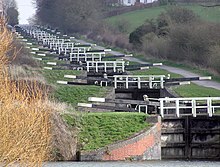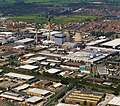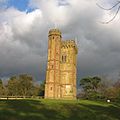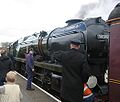Portal:South East England
The South East England Portal

South East England is one of the nine official regions of England in the United Kingdom at the first level of ITL for statistical purposes. It consists of the counties of Buckinghamshire, East Sussex, Hampshire, the Isle of Wight, Kent, Oxfordshire, Berkshire, Surrey and West Sussex. Major towns and cities in the region include Brighton and Hove, Canterbury, Milton Keynes, Southampton, Portsmouth, Slough, Reading and Oxford.
South East England is the third-largest region of England, with a land area of 19,072 square kilometres (7,364 sq mi), and is also the most populous with a total population of over nine million. The region contains eight legally chartered cities: Brighton and Hove, Canterbury, Chichester, Milton Keynes, Oxford, Portsmouth, Southampton and Winchester. The region's close proximity to London has led to South East England becoming a prosperous economic hub with the largest economy of any region in the UK, after London. The region is home to Gatwick Airport, the UK's second-busiest airport, and Heathrow Airport (the UK's busiest airport) is located adjacent to the region's boundary with Greater London. The coastline along the English Channel provides numerous ferry crossings to mainland Europe.
The region is known for its countryside, which includes two national parks: the New Forest and the South Downs, as well as the North Downs, the Chiltern Hills and part of the Cotswolds. The River Thames flows through the region and its basin is known as the Thames Valley. It is also the location of a number of internationally known places of interest, such as HMS Victory in Portsmouth, Cliveden in Buckinghamshire, Thorpe Park and RHS Wisley in Surrey, Blenheim Palace in Oxfordshire, Windsor Castle in Berkshire, Leeds Castle, the White Cliffs of Dover and Canterbury Cathedral in Kent, Brighton Palace Pier, and Hammerwood Park in East Sussex, and Wakehurst Place in West Sussex. The region has many universities; the University of Oxford is the oldest in the English-speaking world, and ranked among the best in the world.
South East England is host to various sporting events, including the annual Henley Royal Regatta, Royal Ascot and The Derby, and sporting venues include Wentworth Golf Club and Brands Hatch. Some of the events of the 2012 Summer Olympics were held in the south east, including the rowing at Eton Dorney and part of the cycling road race in the Surrey Hills.
In medieval times, South East England included much of the Kingdom of Wessex, which was the precursor to the modern state of England. Winchester was the capital of England after unification of the various states, including the kingdoms of Kent, Sussex and Mercia. Winchester stopped being the administrative capital of England some time in the 13th century as its influence waned while the City of London dominated commerce. The last monarch to be crowned at Winchester was Richard II in 1377, although the last monarch to be crowned by the Bishop of Winchester was Queen Mary I in 1553. (Full article...)
Selected article

The Kennet and Avon Canal is a canal in southern England. The name may refer to either the route of the original Kennet and Avon Canal Company, which linked the River Kennet at Newbury to the River Avon at Bath, or to the entire navigation between the River Thames at Reading and the Floating Harbour at Bristol, including the earlier improved river navigations of the River Kennet between Reading and Newbury and the River Avon between Bath and Bristol.
The River Kennet was made navigable to Newbury in 1723, and the River Avon to Bath in 1727. The Kennet and Avon Canal between Newbury and Bath was built between 1794 and 1810 by John Rennie, to convey commercial barges carrying a variety of cargoes, and is 57 miles (92 km) long. The two river navigations and the canal total 87 miles (140 km) in length. The section from Bristol to Bath is the course of the River Avon, which flows through a wide valley and has been made navigable by a series of locks and weirs. In the later 19th century and early 20th century the canal fell into disuse following competition from the Great Western Railway, who owned the canal. Between 1970 and 1990 the canal was restored, largely by volunteers, and today is a popular heritage tourism destination, for boating, canoeing, fishing, walking and cycling. It is also important for wildlife conservation.
There are 105 locks on the Kennet and Avon Canal from Bristol to the River Thames, including six on the navigable section of the River Avon from Bristol to Bath and nine on the navigable section of the River Kennet to its confluence with the Thames near Reading. The remaining 90 locks lie along the 57 miles (92 km) of canal. In Bath the canal separates from the river but follows its valley as far as Bradford on Avon. The ornate Bath Locks lead to a stretch through Limpley Stoke valley with few locks. The flight of locks at Devizes, including the Caen Hill Locks, raises the canal to its longest pound, which then ascends the four Wootton Rivers locks to the short summit pound which includes the Bruce Tunnel. Pumping stations are used to supply the canal with water. The canal continues through the rural landscape of Wiltshire and Berkshire before joining the River Kennet at Newbury and becoming a navigable river to Reading, where it flows into the River Thames. (Full article...)
Selected pictures
Selected biography
Ælfheah (c. 953 – 19 April 1012), more commonly known today as Alphege, was an Anglo-Saxon Bishop of Winchester, later Archbishop of Canterbury. He became an anchorite before being elected abbot of Bath Abbey. His reputation for piety and sanctity led to his promotion to the episcopate and, eventually, to his becoming archbishop. Ælfheah furthered the cult of Dunstan and also encouraged learning. He was captured by Viking raiders in 1011 during the siege of Canterbury and killed by them the following year after refusing to allow himself to be ransomed. Ælfheah was canonised as a saint in 1078. Thomas Becket, a later Archbishop of Canterbury, prayed to Ælfheah just before his murder in Canterbury Cathedral in 1170. (Full article...)
On This Day in South East England
7 May:
1765: HMS Victory, later the flagship of Nelson's fleet was launched at Chatham. The ship is now preserved at Portsmouth.
Categories
Related portals
WikiProjects
Topics
Associated Wikimedia
The following Wikimedia Foundation sister projects provide more on this subject:
-
Commons
Free media repository -
Wikibooks
Free textbooks and manuals -
Wikidata
Free knowledge base -
Wikinews
Free-content news -
Wikiquote
Collection of quotations -
Wikisource
Free-content library -
Wikiversity
Free learning tools -
Wikivoyage
Free travel guide -
Wiktionary
Dictionary and thesaurus































































































































